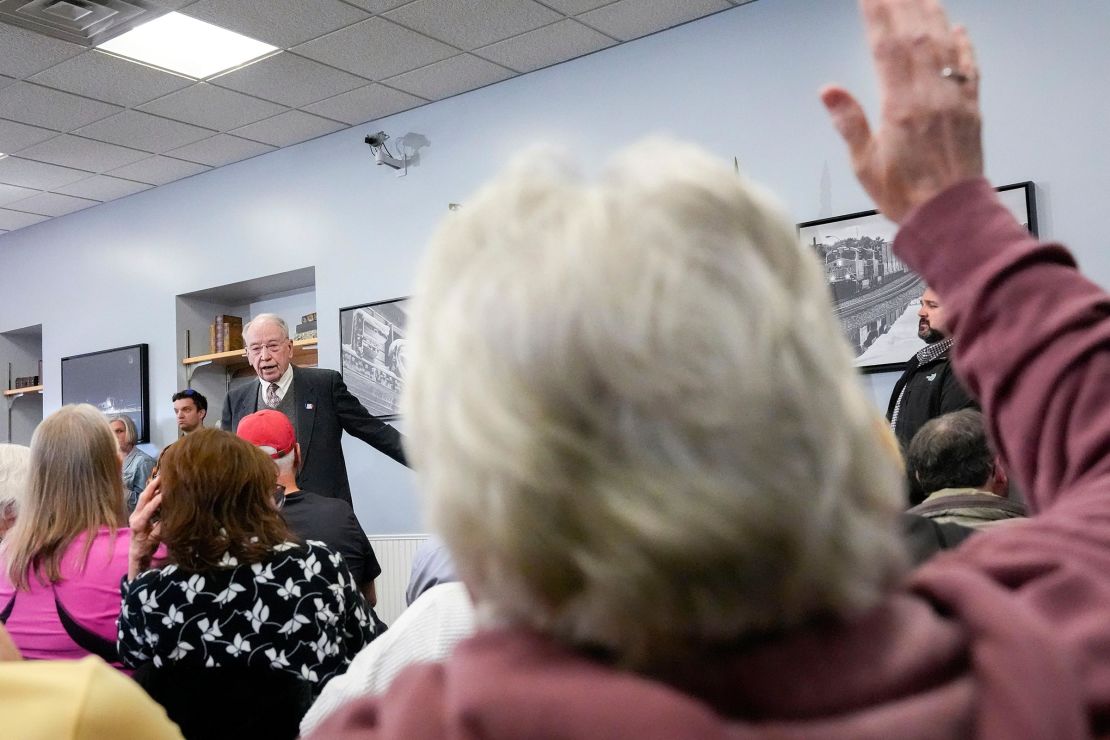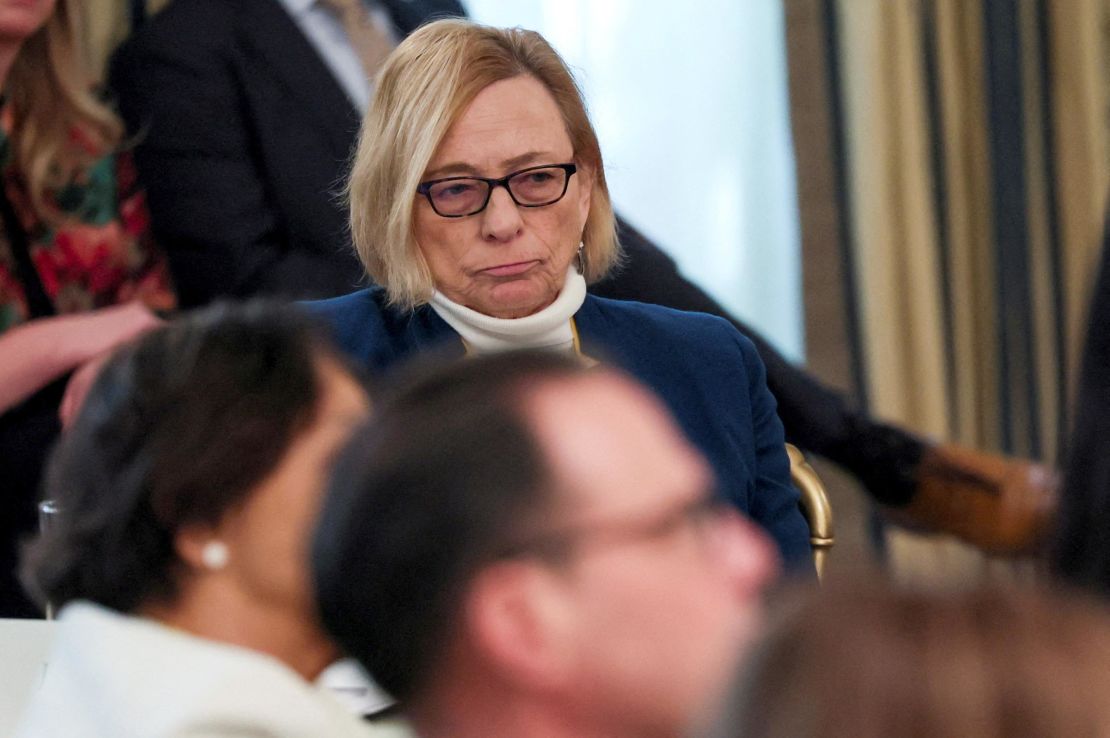Editor’s Note: Donald Trump came back into power making it clear he would use the public office of the presidency to extract personal revenge. The effort is underway, but so is a growing resistance. This is Part 5 of an in-depth and contemporaneous look at the first 100 days of Trump’s second term.
CNN
—
Towering three stories high, the immense balloon of a bloated man scowls at the scene below. With tiny hands, a faux military uniform and a shock of yellow hair, the parody of President Donald Trump sways and buckles in the wind like it is losing air as the crowd gains steam.
“Hands off democracy! Stop the millionaire tax cut! Traitor Trump!”
Thousands of protesters are making themselves heard through signs and chants as they swarm downtown Los Angeles. Similar protests are arising across the country. It is hard to know how many, but easy to hear the fury.
“Resist,” says a sign held by a woman from Pasadena who tells a local Fox news crew, “I’ve lived 80 years, and I can’t see my grandchildren, my great-grandchildren, coming into a world like this with him in charge.”
Independent Sen. Bernie Sanders, a progressive leader from blue Vermont, says at a crowded rally in deep-red Idaho, “We are dealing with a president that undermines our Constitution every single day, who threatens our freedom of speech and assembly, and whose agents — as we speak — are rounding up innocent people in the streets. … What this guy wants is more and more power!”
Although the public outcry against Trump appears to have started later and smaller than it did in his first term, it is escalating. Elected Democrats are being berated by their constituents for not fighting back more, while some Republican lawmakers get the worst of it as their constituents ambush them over the president at town halls.
“How does this person qualify as sane?” a woman shouts at Republican Rep. Michael Baumgartner in Spokane, Washington. “Why is he not being impeached right now?”
“You’re not doing your job!” and “Trump’s not obeying the Supreme Court!” are among challenges hurled at Republican Sen. Chuck Grassley in Iowa. Grassley responds, “You know the only tool … the Constitution gives Congress with regard to disciplining the executive branch is impeachment.”

A man wearing a red baseball hat emblazed with the words “Make Lying Wrong Again” shoots back, “And you missed that opportunity in his first administration.”
The outrage is laced with such venom, GOP congressional leaders advise their elected members to avoid public forums. Speaker of the House Mike Johnson also dismisses the idea that the pushback reflects any unpopularity with what’s going on in Washington, claiming “paid protesters” are at work with no evidence.
If Trump notices or cares about the discomfort of his allies, he gives no sign. He keeps slamming forward with his agenda as the end of his first 100 days looms. High up on the list is revenge.
Just before his November victory, he posted on social media about his concerns over virtually nonexistent election fraud. “Lawyers, Political Operatives, Donors, Illegal Voters, & Corrupt Election Officials. Those involved in unscrupulous behavior will be sought out, caught and prosecuted at levels, unfortunately, never seen before in our Country.”
Some critics saw the statement as a prelude to a campaign of general retribution. The potential list of alleged enemies is long: lawmakers and former officeholders who’ve led investigations into the January 6, 2021, attack, who’ve exposed him to public scrutiny, or who’ve simply made him look bad. Democrats Joe Biden, Kamala Harris and Hillary Clinton are among them, as are Republican former Reps. Adam Kinzinger and Liz Cheney.
Members of Trump’s own first-term team are likely targets, even though he’s often bragged he surrounds himself “only with the best and most serious people.” That includes former Secretary of State Mike Pompeo, former Secretary of Defense Mark Esper, former Chairman of the Joint Chiefs of Staff Gen. Mark Milley, former US Ambassador to the United Nations John Bolton, and the face of the public health response to Covid-19, Dr. Anthony Fauci.
Trump has beefs with prosecutors who brought cases against him — former special counsel Jack Smith, Manhattan District Attorney Alvin Bragg, New York Attorney General Letitia James and Fulton County District Attorney Fani Willis.
Action comes fast. Trump strips security clearances and in some cases protection from a good many on his list, and he pushes for broad investigations. He fires the archivist of the United States after more than two years of bubbling wrath over charges that, as a former president, he mishandled classified government documents. She wasn’t even in the job when he was charged.

He orders his attorney general to investigate two of his former officials for not backing his patently false claim of a stolen election in 2020.
Trump tears into several big law firms that have represented perceived political foes, cutting their access to federal government buildings and officials. The move makes it impossible for them to represent other clients who have business with the government, and some firms cave — promising to take on more Republican staff and donate hundreds of millions of dollars in free legal work for causes Trump supports. Others dig in, hire defense counsel and reinforce the joke that MAGA stands for “Making Attorneys Get Attorneys.”
Trump rips into higher education, stripping visas from hundreds of foreign students and arresting or detaining others whom he accuses of supporting terrorism, in some cases apparently by just attending pro-Palestinian protests. He threatens to pull federal research grants unless universities adjust their policies to his liking, especially in regard to admissions, diversity programs and gender roles in sports. The Ivy League schools are heavily targeted, and some make the deal.
Harvard, however, with billions in federal funding at stake, takes a different tack. After it rejects the administration’s policy demands, the administration freezes $2.2 billion in multi-year grants.
Harvard then sues the administration, claiming the government is violating its constitutional rights.
“No government — regardless of which party is in power,” Harvard President Alan Garber writes to the school community, “should dictate what private universities can teach, whom they can admit and hire, and which areas of study and inquiry they can pursue.”
The White House’s approach of threatening legal action to force acceptance of onerous terms provokes unofficial accusations of extortion from some onlookers. But with the Justice Department bending so thoroughly to Trump’s will and the Supreme Court ruling presidents have wide immunity, it is unclear where such a charge can go.
The Trump administration pushes on, suing the state of Maine for allowing transgender athletes to take part in school sports. The issue heated up weeks earlier when Trump confronted Democratic Gov. Janet Mills at a meeting of governors and demanded she obey his executive order banning trans women from competing in women’s sports. To his consternation, she replied, “We’ll see you in court.”

Trump rips into the media, airing his complaints established in standing lawsuits against major television networks and local outlets alike, alleging unfair coverage. Speaking at the Justice Department, he calls several mainstream news outlets “corrupt,” adding, “It’s totally illegal what they do. I just hope you can all watch for it, but it’s totally illegal.”
Again, some settle the suits he has filed against them, while others lawyer up and prepare for battle. The White House press office announces new rules asserting control over which news outlets are given prime spots for presidential access — throwing elbows at some mainstream media organizations. Some much smaller, Trump-friendly outlets, gain new prominence in the pecking order. The global Associated Press is shoved out because it will not change its industry-standard stylebook to call the Gulf of Mexico the Gulf of America, sparking a legal battle.
Trump’s seething anger and thirst for revenge is so apparent, when a constituent tells Sen. Lisa Murkowski she is afraid of the political climate, the Alaska Republican gives this startling reply.
“We are all afraid,” she says. “I’m oftentimes very anxious myself about using my voice because retaliation is real. And that’s not right. But that’s what you’ve asked me to do, and so I’m going to use my voice to the best of my ability.”
The New York Times’ Maggie Haberman, who has covered Trump for decades, watches the revenge tour and says, “I think there has been an evolution in how he is using the levers of government.” She points to the way he is personally targeting individuals and ordering investigations, saying, “that is a line crossed that we had not seen before.”
Still, for many Trump supporters, the first 100 days have produced exactly the results for which they have voted and prayed. For decades, many have complained nothing really changes even when Republicans hold all the seats of influence. A refrain on the political right in all those long, frustrating years was that the left, the middle and the courts were always watering down, eroding and pushing aside conservative legislation. Trump’s willingness to smash through norms, even if that means defying Congress and seemingly sidestepping the courts, has made him the champion the right has wanted, and he is being rewarded.
An NBC News poll finds 71% of Republican registered voters now call themselves MAGA. That is an expansion of his base, and it has driven up the share of voters identifying with MAGA to 36%, compared with 27% of respondents last year, and 23% the year before that.
But MAGA is still just over one-third of the electorate.
Beyond the faithful, Trump’s poll numbers are dire. The president is busily claiming falsely that gas and food prices have dropped dramatically. Yet a CBS News/YouGov survey finds a rise in voters who think America’s financial situation is getting worse with Trump in office — now at 53%. From just March to April, voters have switched more than 2-to-1 from blaming former President Joe Biden for the state of the economy to blaming Trump.
“Americans are not buying what Donald Trump is selling them,” CNN’s chief data analyst, Harry Enten, says. “Americans have switched on a dime on the economy, on Donald Trump, in large part because of the tariffs, which they increasingly do not like.”
A CNN/SSRI poll released April 27 shows Trump’s approval ratings on economic issues have dropped notably since early March. On inflation, his approval is down 9 points to 35%, and on tariffs themselves, it’s down 4 points to 35%.

When Federal Reserve Chair Jerome Powell repeats the warning that Trump’s tariff plans will probably raise inflation and slow down the economy, the president is apoplectic. He has wanted the Fed to adjust interest rates, ostensibly to offset the economic trouble he himself has triggered. The president has nudged the idea of firing Powell before his term expires in May 2026, and although courts have yet to settle whether Trump has that power, now he says, “Termination can’t come fast enough.”
He’ll continue to shift his rhetoric — saying he has “no intention” of firing Powell after advisers warned that terminating the central bank chief would backfire legally and economically – before attacking him again the next day.
He does not call for anyone to be fired after the biggest scandal of his fledgling term in mid-March. As US warplanes prepared to launch an attack against Houthi rebels in Yemen, Defense Secretary Pete Hegseth, national security adviser Mike Waltz, Vice President JD Vance and other officials chatted on a messaging app called Signal. They wrote openly about sensitive details, including weapons and strike times, unaware that Waltz added the editor-in-chief of The Atlantic to the group chat.
Waltz says he doesn’t know how it happened, but some members of Congress call it a serious security breach. Trump and his defenders dismiss it as a tempest in a teapot, and he directs most of his disdain at journalist Jeffrey Goldberg, whom he loathes, in part, for past stories unfavorable to the president. A similar story arises around Hegseth sharing that sensitive information on a second Signal chat that included his wife and brother.
But economic issues keep pushing into the headlines. And as his campaign promises of instantly lower prices fail to materialize, Trump’s appearances in an Oval Office heavily redecorated with golden hardware strike some critics as out of touch. He is unperturbed. He’s also planning to pave over the iconic Rose Garden to create a patio like he has at Mar-a-Lago and talks about building a $100-million White House ballroom.
He and his acolytes tell Americans there may be a little bit of pain before the American richesse he promises from tariffs arrives. His party instantly pivots to the new message.
“To make transformational change, it’s going to take some time,” Republican Rep. Lisa McClain of Michigan says, and defending Trump against criticism that he pulled a bait-and-switch, she adds, “it depends on what lens you are looking at this through.”
One of the most striking speeches since Trump reassumed the office of president of the United States did not come from him. Or from a senator. Or from anyone else in Washington, DC. It came just 2 miles away from the tomb where President Abraham Lincoln was laid to rest after he was killed in the wake of America’s devastating Civil War.
At the Illinois Capitol in February, Democratic Gov. JB Pritzker gave his annual address to the state’s General Assembly, winding through state issues.
Then he talked about Trump. Pritzker noted, as a Jewish American, the memory of intolerance in the time of Nazi Germany is never far from mind. Then he said this.
“I just have one question: What comes next? After we’ve discriminated against, deported or disparaged all the immigrants and the gay and lesbian and transgender people, the developmentally disabled, the women and the minorities — once we’ve ostracized our neighbors and betrayed our friends — after that, when the problems we started with are still there staring us in the face — what comes next?”
The bewildering speed of the changes under this new administration has made it hard for many voters to recall what happened even a week ago, let alone since the inauguration.
It is relatively easy, however, to see that Trump has remade the nation’s political, social and legal landscape in ways few thought possible — so much so that some Democrats, Republicans and independents alike talk of the country soon being unrecognizable. Some hope for it. Some fear it. Trump’s reforms may be erased by courts, public outcry or future elections — perhaps quickly, maybe slowly. Or they may remain as the new standards for life in this country. The only constant for voters on both sides of the political chasm cutting through states, communities and families appears to be a gnawing uncertainty.
After 100 days, what comes next?

CNN’s Kaanita Iyer contributed to this report.
